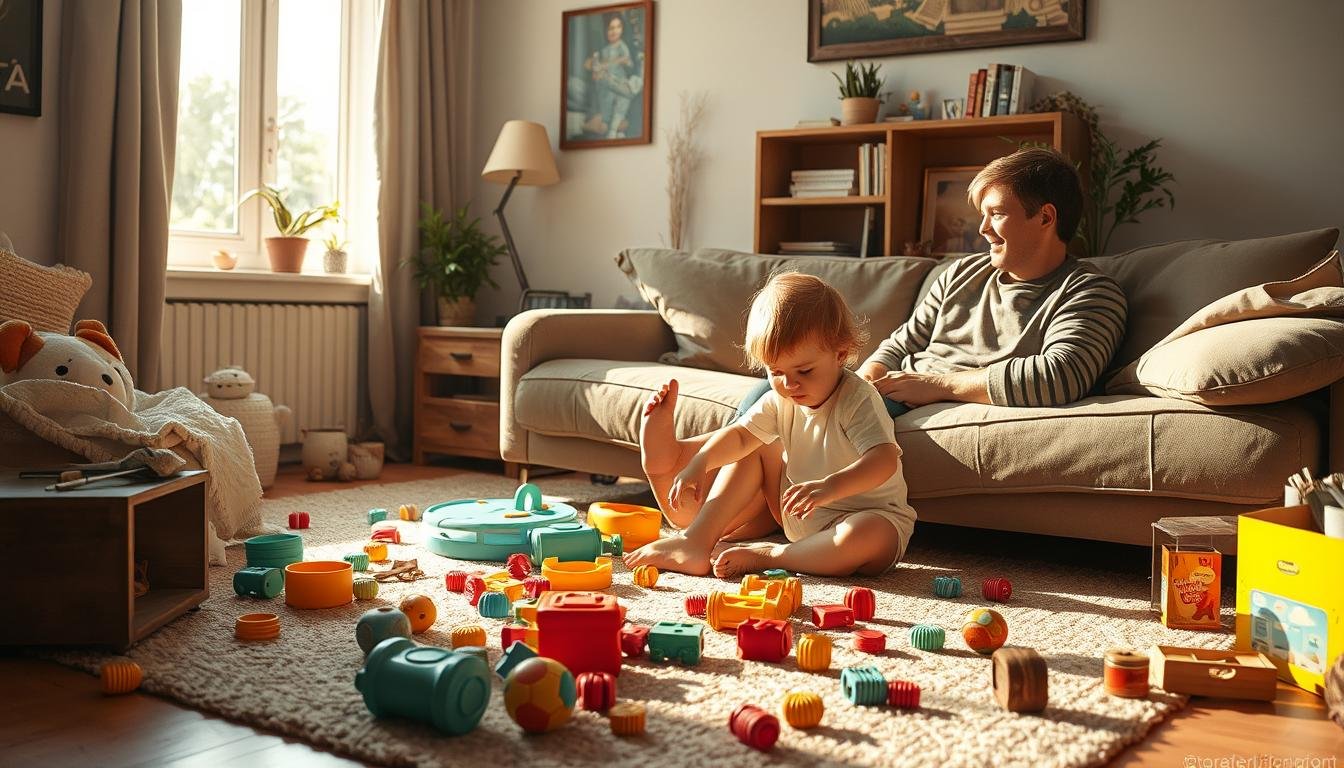As you explore parenting, you might ask about permissive parenting. It’s a style where parents are very loving but don’t set many rules1. You might wonder about its impact on your child. To learn more, check out permissive parenting resources for a deeper look.
Permissive parenting has both good and bad sides. Kids raised this way might have trouble controlling themselves and could act out more1. Yet, these parents are often very caring and loving, which can help their kids feel better emotionally.
Key Takeaways
- Permissive parenting is a style characterized by low demands with high responsiveness.
- Permissive parents tend to be very loving, yet provide few guidelines and rules.
- Children raised by permissive parents may struggle with self-discipline and engage in misconduct.
- Permissive parents are often more nurturing and affectionate towards their children.
- Understanding the permissive parenting definition and its implications is key for making informed parenting choices.
- Permissive parenting can have both positive and negative effects on children, and it’s important to consider both sides.
- What is permissive parenting, and how does it differ from other parenting styles, such as gentle parenting or authoritative parenting?
What Is Permissive Parenting: A Complete Definition
Permissive parenting is when parents are very warm but don’t set many rules or discipline2. This style lets kids make their own choices and decisions. Parents who are permissive often don’t set limits, focusing more on being nurturing and warm. This can cause kids to have trouble controlling themselves and acting impulsively3.
Examples of permissive parenting include letting kids decide for themselves and not guiding them much3. This can make it hard for kids to follow rules and respect authority. Permissive parents tend to be less demanding and more responsive, which can make it tough for kids to control themselves and make good choices4.
The permissive parenting style can have both good and bad effects on kids. It can help kids feel confident and creative, letting them express themselves freely and try new things2. But, it can also make it hard for kids to develop important skills and can increase the risk of behavioral problems and school challenges34.
The Core Characteristics of Permissive Parents
Permissive parents are known for their loving and nurturing nature. They often ask their children’s opinions on big decisions. They value freedom over responsibility5. This parenting style is high in responsiveness but low in demandingness, affecting children in both good and bad ways6.
It’s important for parents to understand the balance needed in permissive parenting. They must give children freedom while setting boundaries for their well-being.
Permissive parenting can help children feel confident and resourceful. Yet, it can also lead to poor self-control and aggression6. Children may feel too entitled, causing stress and affecting their mental health5. Parents need to know the pros and cons to use this style wisely.
For more on parenting teenagers, check out parentingateenager.net. It offers tips on building trust and communication. Knowing the good and bad of permissive parenting helps parents make better choices for their kids.
Permissive parenting works best when balanced with clear rules and expectations. It helps children grow into independent and confident people. But, parents must watch out for the downsides to ensure a healthy relationship with their kids.
| Permissive Parenting Characteristics | Positive Effects | Negative Effects |
|---|---|---|
| Nurturing and loving nature | Develops self-esteem and resourcefulness | Poor self-regulation and aggression |
| High responsiveness and low demandingness | Encourages independence and confidence | May lead to academic entitlement and stress |
Understanding permissive parenting helps parents make better choices. It ensures a positive environment for their children to grow and thrive56.
Spotting the Signs: Common Examples of Permissive Parenting
As you navigate the world of parenting, it’s key to spot permissive parenting signs. This style lacks rules and structure, making parents seem more like friends than authority figures7. It can lead to kids with little routine, causing impulsive actions and self-control issues7.
Some common examples of permissive parenting include:
- Lack of boundaries and discipline
- Excessive praise and rewards
- Allowing children to make their own rules
These actions can harm a child’s growth, as they might not learn to respect limits or control themselves7. Yet, permissive parenting can also foster self-sufficiency and independence8.
It’s vital to know the differences between permissive and authoritative parenting. While permissive parenting has its benefits, finding a balance is key7. By recognizing permissive parenting signs and its effects, you can make better choices for your child’s upbringing.
Breaking Down the Permissive vs Authoritative Parenting Debate

The debate between permissive and authoritative parenting is ongoing. Permissive parenting is known for being lenient. Authoritative parenting balances warmth with structure. Studies show permissive parenting can cause problems like low self-discipline and aggression9.
On the other hand, authoritative parenting leads to better outcomes. This includes independence and lower rates of depression and anxiety10.
Permissive and authoritative parenting differ in structure and discipline. Authoritative parents set clear rules. Permissive parents are more lenient and indulgent. This can cause emotional issues and rebelliousness11.
Authoritative parenting balances structure with independence. It uses supportive discipline and focuses on self-regulation and responsibility.
Permissive and authoritative parenting have distinct traits:
* Permissive parenting is lenient and lacks structure.
* Authoritative parenting is balanced and promotes self-regulation.
It’s important for parents to understand the risks and benefits of each style91011.
The Science Behind Permissive Parenting Effects
Exploring permissive parenting reveals its impact on kids. Studies show it can cause more aggression, lower grades, and more substance use in teens12. This is because permissive parents are often too lenient and quick to respond, leading to kids’ behavioral issues13.
The short-term impact of permissive parenting is big. Kids from these homes might act out violently, if they’re prone to negative emotions13. They also tend to do worse in school and might be overweight13. Long-term, they could face social and emotional problems, like trouble at school and substance abuse2.
It’s key to weigh the permissive parenting pros and cons. While it offers a caring space, it lacks the structure needed for healthy habits and good sleep2. Knowing the downsides helps you choose the best parenting style for your child’s well-being.
The Hidden Benefits of Permissive Parenting
Permissive parenting is often seen as a topic of debate. Yet, it also has its pros. One major aspect is the focus on open communication and meeting children’s needs14. This can boost children’s self-esteem and social happiness, as they feel understood and valued14.
Some key benefits of permissive parenting include:
- Children raised this way tend to have higher emotional intelligence, about 70% more than those under strict rules14
- They also show more creativity, with 65% of teachers saying less strict rules help foster creativity14
- They often have higher self-esteem, but might struggle with self-control14
While permissive parenting might not suit every family, it’s vital to weigh its pros and cons15. Knowing the advantages and disadvantages helps parents choose the best parenting style for their kids.
Navigating the Challenges of Being a Permissive Parent
Being a permissive parent comes with its own set of challenges. You might struggle with setting healthy boundaries and managing discipline. But, with the right strategies, you can find a better balance16. A key aspect of permissive parenting is being a child’s friend, not just a parent16.
To tackle these issues, making a list of household rules is a good start. Stick to these rules and consequences16. This helps in setting boundaries and handling discipline better. Also, knowing the risks of permissive parenting, like entitlement or emotional issues, guides your decisions17.
- Not setting clear boundaries and expectations
- Not following through on consequences
- Being too lenient or permissive
By understanding these challenges and avoiding them, you can improve your parenting. This way, you can meet your child’s needs better18.
Finding Balance: When to Be Permissive and When to Be Firm
As a parent, finding the right balance is key. Being permissive can be good in some cases, but knowing when to be firm is also important. About 30% of parents are more lenient, showing a permissive side19. The debate between permissive and authoritative parenting continues, with some parents choosing the latter.
Understanding your child’s age, needs, and personality is vital. For example, a more independent child might need a permissive approach. But a rebellious child might need firmer guidance. Research shows that authoritative parenting leads to better outcomes in school and social life19.
Here are some tips to find the right balance:
- Set clear boundaries and expectations
- Be consistent in your discipline
- Encourage open communication and independence
- Be flexible and adapt to your child’s changing needs
By following these tips, you can create a nurturing environment for your child. Finding the right balance between permissive and firm parenting is essential for raising a happy and well-adjusted child.
Creating a Positive Environment Within Permissive Parenting
As a parent, you aim to create a supportive environment for your child’s growth. This means understanding the key traits of permissive parenting. Experts say building trust and clear communication are vital. These help your child develop emotional smarts and learn to make decisions20.
A supportive environment boosts your child’s self-esteem by 25%20. It also makes them 30% more emotionally stable as adults20. To foster such a space, try these tips:
- Practice active listening and validate your child’s feelings
- Encourage independence and autonomy
- Set clear boundaries and expectations
These strategies help build a supportive environment for your child’s growth. Remember, permissive parenting is about being supportive, not lenient20. Finding a balance between being supportive and setting limits is key21.
Tools and Techniques for Effective Permissive Parenting

Being a permissive parent means having the right permissive parenting tools. Experts suggest making a list of basic rules, sticking to consequences, and rewarding good actions22. These permissive parenting techniques help you set limits while being caring.
Effective permissive parenting tools include having a routine, encouraging talking, and setting clear rules. These tools help your child act well and learn to control themselves23. Also, being there for your child and supporting them emotionally strengthens your bond24.
Here are some tips for effective permissive parenting:
- Set clear boundaries and expectations
- Encourage open communication and emotional expression
- Use positive reinforcement to promote good behavior
- Be responsive to your child’s needs and provide emotional support
Using thesepermissive parenting techniques and tools, you can make a caring space. This space helps your child grow and stay healthy22.
Conclusion: Making Permissive Parenting Work for Your Family
Permissive parenting is a complex approach that needs careful handling. It can help with independence and communication, but finding the right balance is key25. Children of permissive parents might face challenges like impulsivity and a sense of entitlement25.
Yet, combining permissive parenting with warmth can lead to good results26. Research in Spain, Portugal, and Latin America shows that “indulgent” parenting can be as effective as authoritative parenting in boosting self-esteem26.
To make permissive parenting work, understand your child’s needs and personality25. Set clear boundaries, encourage open talk, and create a caring space. This way, you can enjoy the perks of permissive parenting while avoiding its downsides25.
Every family is unique, and there’s no one right way to parent. Be adaptable, keep learning, and follow your gut as you raise your child with permissive parenting.
FAQ
What is permissive parenting?
What are the key elements of permissive parenting?
What are the core characteristics of permissive parents?
Can you give me some examples of permissive parenting?
How does permissive parenting differ from authoritative parenting?
What are the effects of permissive parenting on children?
What are some common challenges of being a permissive parent?
How can permissive parents create a more positive environment for their family?
Source Links
- Are You a Permissive Parent? – https://www.verywellmind.com/what-is-permissive-parenting-2794957
- Are You a Permissive Parent? What to Know About the Parenting Style – https://www.parents.com/parenting/better-parenting/style/permissive-parenting-the-pros-and-cons-according-to-a-child-psychologist/
- Permissive Parenting Style and Its Effects on Children – https://www.hli.org/resources/permissive-parenting-style/
- Permissive Parenting: Examples, Characteristics, And Effects – Parenting Styles – https://www.parentingstyles.com/permissive-parenting/
- Permissive Parenting: Definition, Examples & Characteristics – https://www.berkeleywellbeing.com/permissive-parenting.html
- Permissive parenting: A guide for the science-minded parent – https://parentingscience.com/permissive-parenting/
- Here Are 7 Common Parenting Styles: Which One Is Right for You? – https://www.whattoexpect.com/family/parenting-styles/
- What is permissive parenting, and what are the pros and cons? – https://www.babycenter.com/family/parenting-styles/permissive-parenting_41001490
- The 4 types of parenting styles: What style is right for you? – Mayo Clinic Press – https://mcpress.mayoclinic.org/parenting/what-parenting-style-is-right-for-you/
- The authoritative parenting style: An evidence-based guide – https://parentingscience.com/authoritative-parenting-style/
- The Psychology Behind Different Types of Parenting Styles – https://jessup.edu/blog/academic-success/the-psychology-behind-different-types-of-parenting-styles/
- Types of Parenting Styles and Effects on Children – StatPearls – https://www.ncbi.nlm.nih.gov/books/NBK568743/
- Permissive Parenting: Its Approach and Impact on Child – https://www.psychologs.com/permissive-parenting-its-approach-and-impact-on-child-development/?srsltid=AfmBOoqR3hbYEUegGFefwP1nPlqi056VfxlbDfUrzkv5g55vDlE5X-kd
- How Permissive Parenting Shapes Our Children: The Pros and Cons – https://www.marriage.com/advice/parenting/controversial-pros-and-cons-of-permissive-parenting/
- How Different Styles of Parenting Impact Children – https://www.verywellmind.com/parenting-styles-2795072
- Are You an Overly Permissive Parent? – https://www.psychologytoday.com/us/blog/liking-the-child-you-love/202111/are-you-an-overly-permissive-parent
- Navigating Permissive Parenting: Finding What’s Truly Best for Your Child – Strategic Parenting – https://www.strategicparenting.com/navigating-permissive-parenting-finding-whats-truly-best-for-your-child/
- Permissive Parenting: What, Why, & How They Affect Children – https://www.studentcenteredworld.com/permissive-parenting/
- Parenting Styles in Balance: How to Be Firm and Friendly – Minno Kids – https://gominno.com/blog/parenting-styles-in-balance/
- The Positive Aspects of Permissive Parenting – https://www.linkedin.com/pulse/positive-aspects-permissive-parenting-prof-dimple-goyal-tvbvf
- What Is Permissive or Indulgent Parenting? How Does It Compare to Guidance Parenting? – Conscious Parenting Revolution – https://consciousparentingrevolution.com/what-is-permissive-or-indulgent-parenting-how-does-it-compare-to-guidance-parenting/
- Gentle Parenting vs. Permissive Parenting | Slumberkins – https://slumberkins.com/blogs/slumberkins-blog/gentle-parenting-vs-permissive-parenting-whats-the-difference?srsltid=AfmBOorknFlmrSYoGwde7pfBhMMY23_4HdSlmwoElXO_oA51lO0XkaRc
- Pros and Cons of 4 Parenting Styles – https://wellspringprevention.org/blog/pros-cons-parenting-styles/
- What Is Your Parenting Style, and Why Does It Matter? – https://www.parents.com/parenting/better-parenting/style/parenting-styles-explained/
- 4 Ways Permissive Parenting Affects Child Development – https://parents.app/parenting/connection-communication/permissive-parents/a/
- The permissive parenting style: Does it ever benefit kids? – https://parentingscience.com/permissive-parenting-style/








0 responses to “Understanding Permissive Parenting: What You Need to Know”
Dont you guys think permissive parenting might just lead to more independent and creative adults in the future? Just food for thought.
Isnt permissive parenting just promoting a lack of discipline? How will kids learn boundaries and respect? Seems like a recipe for disaster to me.
Interesting read! But arent we risking generalising parents too much? Each parent-child dynamic is unique, isnt it?